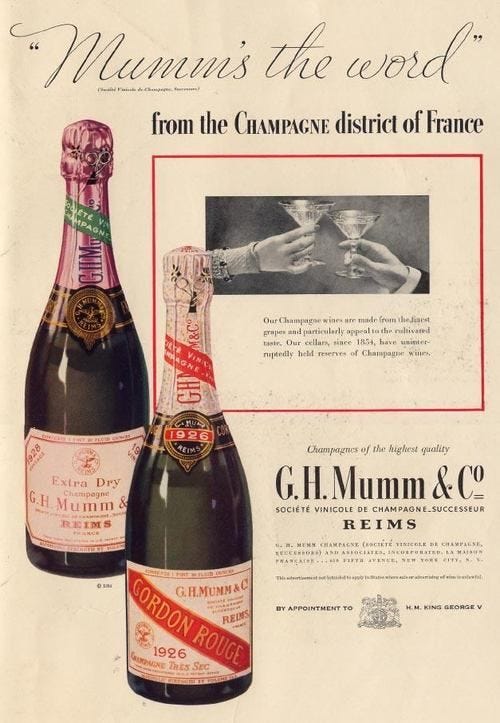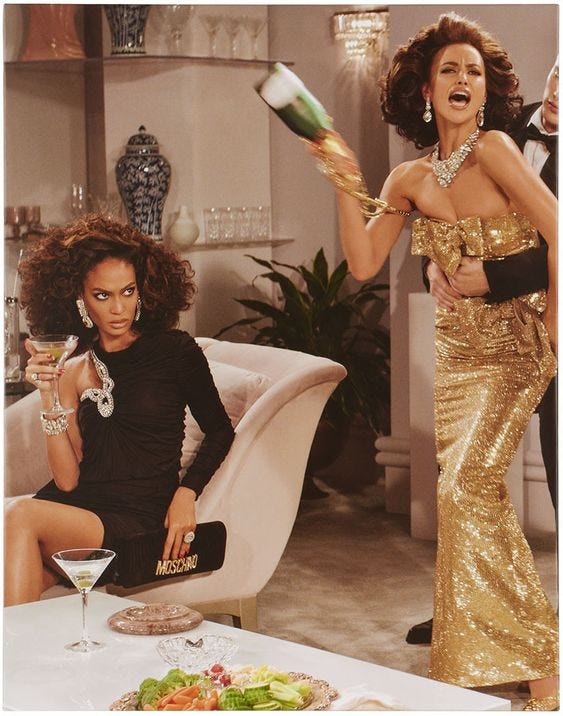After my first post, So You Want to Learn More About Wine, my friends followed up with a fair question: Well, what do I pick? And how should I pick wine? At first, I was hesitant to write an answer. There are plenty of professionals whose entire job is to guide people into the wine world. For instance, Wine Folly is a great resource for learning bare-bone facts. Still, I wanted to create a personalized list for my girlfriends/boyfriends that I trust would be enjoyable. My ulterior motive is also to nudge them on which wines I would like to be gifted when the season rolls around.
A word on my wine list and images. The wine list is California-centric and hyper-local. In earnest, I’m in the early stages of my wine career, and my local productions are what I’m familiar with for now. Also, there aren’t any bottle shots on this list because they can sometimes be tricky to find. For the sake of consistency, I’ve decided to feature images that I hope convey the glossy advertisements enjoyed during the height of magazines.
Sparklings
Sticking to the theme of California-focused lists, I won’t discuss Champagne or any local renditions of the style in this post. The topic is a league of its own and deserves a proper discussion. For now, I will excitedly touch on sparkling wines utilizing non-traditional Champagne grapes. For example, the golden delicious apple of my eye, the 2021 Markus Sparkling Bacchus. Grown in the Mokelumne Glen Vineyard, which houses over fifty different varietals of German and Austrian grapes. Swiss-born Markus Niggli produces exciting white wine blends and single varietal bottlings of their grapes. Brut Nature and Methode Champenoise, the sparkling Bacchus has a complex choreography of soft mousse, wet stone minerality, apples, and pears. It is both unique enough to impress the hardest wine veterans and approachable enough for curious new wine lovers. A word on the Markus Wine Co. team: if you have the privilege to see them in action, the funny and lovable trio is like watching a three-man act of Neil Simon’s Odd Couple.
Chardonnay
Being one of the world's most popular varietals comes with the price of being misunderstood. If Chardonnay had a playlist, I think Britney Spears’ Lucky and Nina Simone’s Please Don’t Let Me Be Misunderstood would be on the tracklist. My advice is to let the various production methods serve as a litmus test for finding your palette. Just remember, similar to the ability to critique music well, it’s healthy to appreciate all styles. For my studies on Central Coast Wines, I’m enjoying the 2017 Au Bon Climate Santa Barbara County and the 2021 Sandhi St. Rita Hills Chardonnays. Jim Clendelen, Sashi Moorman, and Rajat Parr are lovers of Burgundy. Utilizing the famed region as a North Star, our winemakers produce their Chardonnay with finely integrated oak usage with the intention of showcasing the characteristics of being grown in Santa Barbara County. Both wines are quite similar in terms of structure - gently oaked, softly malolactic, with an overtone of crisp citrus that drives the wine. The devil is in the details. Au Bon Climat with a touch of more joyful oak usage and ripe green apple acidity. Sandhi, sourced from the Domaine De La Cote and Hines Estate Vineyard, has a citrus fruit front driver that is followed by a delicious lemon drop finish.

Pinot Grigio, Vermentino, and Fiano - Italian White Wines
For Italian White Wines, please look to
and their recently published newsletter written by Jordan Mackay on Discovering Italian White Wine, which now should be required reading for all wine certifications covering the topic. My darlings are getting started in wine; if you take anything away from this post, please take that Mediterranean wines make for great flavor discovery with some of the best values on the market. The 2022 Massican Hyde Vineyard Chardonnay dispells everything you thought you knew about Chardonnay. But Anna, we just covered Chardonnay? Dear readers, like Plato’s Theory on Forms, Massican = Mediterranean Style White Wine, and we must talk about Dan Petrowski’s Chardonnay. Nothing transports me to the salinity of jumping into Cinque Terre Waters like drinking Hyde, a wine that washes your palate with a force wave of citrus, white florals, and wet tidal rocks. If you can’t afford an Italian Summer right now, a bottle of Massican is the next best thing. Sidenote: the shade of blue used on their labels officially lives in my head as Massican Blue.Another recent big love is the 2021 Dry Creek Farm Preston Family White Wine, now made with the care of head winemaker Grayson Hartley. The blend is reminiscent of Friulian-style Super White Blends. Mackay describes it best.
Monovarietal versions of these wines exist, but Friuli also has a culture of complex blends, dubbed “super whites,” a trend spearheaded by Jermann in the late 1970s with the wine called Vintage Tunina (Sauvignon, Chardonnay, Ribolla Gialla, Malvasia) and still important today in such wines as Flor di Uis (Malvasia, Riesling, and Friulano) from Vie de Romans.
Preston’s White Wine - CCOF certified grapes with a heart for old school organics - bursts through the palate with fresh lemon rind acidity from the skin ferment-driven Sauvignon Blanc, which softens as the Ribolla Gialla lime-like notes enter and Tocai Friulano finishes with ripe stone fruit juices. Last enjoyed in Thailand at midnight during hundred-degree weather, I recall thinking that soft layers of fruit tones were the only thing that could withstand the heat of these long summer nights.

Albarino & Assyrtiko
Imagine the opening scene of a classic coming-of-age movie where the narrator explains who the cool girl is as she walks into the room. Albariño is that cool girl. Her parents are from Rias Baixas, Spain, but she was raised in California. She’s stone fruit toned, crisp, and lean. Somehow, she always manages to pair with everything, and all the somms love her when she smells like white flowers. All humor aside, Albariño and other Iberian peninsula grapes thrive out in the Borden Ranch AVA. Many plantings are from vineyards owned by Markus Bokisch, owner of Bokisch Wine. 2021 Ferdinand Albariño - grown in the CCOF Certified Vista Luna Vineyard - is the creative product of Evan Frasier, who is also the general manager of Kongsgaard Wine. Let me pause the wine geekery to say that Ferdinand’s chic modern bottle design satisfies the girl in me who loves a little black dress silhouette. Back to the flavor profile. Crisp white florals and freshly picked kumquat, yet with body driven by eight months of sur lie aging in barrels. If you see this in the shops, snatch it quickly because they fly off our shelves over the course of a weekend.
We’re not out of the Mediterranean yet because we need to talk about the Perlegos Assyrtiko. Jeff and John Perlegos are first-generation Greek American winemakers who grow at the popularly allocated Stampede and Cherryhouse Vineyards. Known almost autochthonously to Santorini, the Perlegos family responsibly farms one of the few stateside Assyrtiko plantings at the Thera Block Vineyard in Clements Hills. The lime zest acidity and ocean air salinity gently ripple onto the palette with the slightest minerality of crushed seashells. A curious palette quencher, leaving the drinker curious for another sip. Truly cannot wait for more winemakers to discover and play with Thera Vineyard Assyrtiko. For a fascinating deep dive into the family’s history growing up in Lodi, please listen to their episode on the Winemakers Podcast.
Cinsaut
In a landscape where lighter-styled red wines are becoming increasingly popular, I’m quite lucky to work down the street from the Bechtold Vineyard Cinsaut. Legend has it that Randall Grahm coined the vineyard during his Bonny Doon Days as possibly the oldest known plantings of Cinsaut. Coveted by many winemakers, it is exciting to see the different productions from the Bechtold Vineyard - whether in the candied red fruit style on its home estate at Jessie’s Grove or blended by Greg La Follette in the 2021 Marchelle Old Vine Family Cuvèe - I always return to the 2022 Lorenza Cinsaut. Lorenza is a force majeure winery founded by Melinda Kearney and Michèle Ouellet-Benson. Frontliners in the modern rosé movement, the mother-daughter team have crafted a seamlessly integrated space where lifestyle meets wine. The wine, while lighter in style, absolutely holds muscle. The way I describe it to the surprised drinker is that big reds are akin to the muscles of a bodybuilder, whereas the Lorenza Cinsaut holds the lean muscle of a ballet dancer. The wine shows restraint in the choreographed nuances of Bulgarian roses and wild strawberries. Ultimately, if nothing else, the wine teaches that there is strength in being soft.
Beaujolais Nouveau or Anything Carbonic In Style
When I first started in the wine industry, Beaujolais Nouveau was clutch when encountering a French wine list. Historically known for affordability and approachability, Beaujolais is a wine region in France that typically utilizes Gamay grapes and is known for its Carbonic Maceration vinification style. The result is a wine that showcases a lighter structure and brighter fresh fruit notes. Please see Eric Asimov’s recently published article for a quick beat on the state of Beaujolais today.
In contrast to France, laissez-faire stateside wine laws allow winemakers to express their full creativity. The outcome of California’s creative force for wine? Birichino Car Car Glou Glou Akashita Old Vine Carignan. The grapes are from 1920 Era Plantings of Carignan from Montague Vineyard, meticulously managed by the Shinn Family in Lodi. It is produced in Santa Cruz by Birichino, a company headed by Alex Krause and John Locke, whose focus is to source grapes from old vines and make wine using a light-handed approach. The Carbonic Carignan featuring little green Japanese spirit (friends with Slimer?) begins with a gentle bouquet of potpourri followed by notes of freshly foraged cherries, ending with a delicate earthiness that is reminiscent of a cool, foggy hike in the Santa Cruz Mountains.
Zinfandel
Last but not least, emblematic of Old California, Zinfandel. As highlighted throughout the beginning of this post, Lodi has long been a source of winegrape diversity to California winemakers. As starlet wine figures swing by and young talent leave town, it is only befitting that I end this post honoring the families that continue to keep the region’s legacy going. In case you didn’t see his front cover article with the LA Times, my dear boss Stuart Spencer, above all else, is a stalwart for family and our local community. In the ever-changing trend cycle, his winery, St. Amant, remains a pillar for the wines harkening to the style of Old California. With one of the best value Old Vine Zinfandel in town, Stuart’s showcase of the historic Mohr-Fry Ranch produces svelte yet meticulously choreographed Zinfandels. Like anyone who works with my boss, all careful flavors, blackcurrant, and layered spices are intentionally thought out. When my family wants to open a high-production concoction from Napa, his wines are the ones I insist on instead. But Anna, don’t younger generations prefer low alcohol, high acid, light style reds? Well reader we do. Yet, in the same way, I sport my Saint Laurent Gloss Leathered Mules with my Dad’s Levi Trucker Jacket from the 80s; I can love full-bodied reds, too.
So there you have it, a zippy list of wines to enjoy. But Anna you didn’t even mention Cab-Not right now reader, I have reached the end of my budget for this wine list. The other noble grape varietals will be saved for a later time. For now, if you like this post and see me out in the wild, please offer me a coffee because it took forty-two cups to write this post.






Lovvvve this! So fun and informative!! Thank you for including Lorenza. Xo